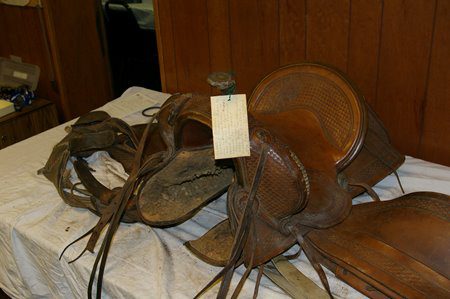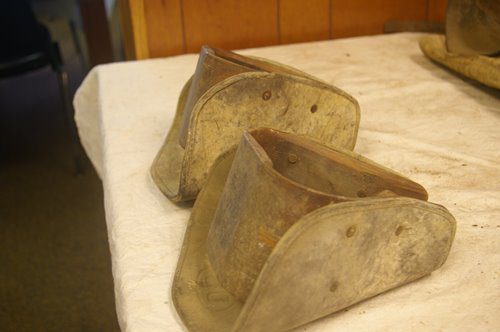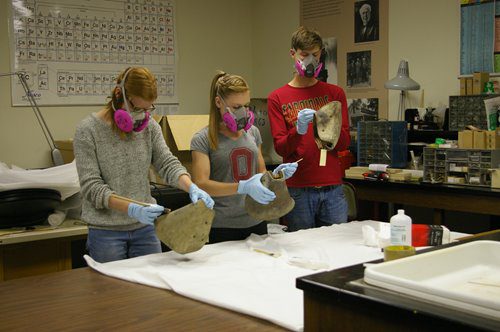Hi! We’re Erin Rose, Caroline and Andrew, a few members of the Summer 2015 Intern Program working with the History Collections Department at the Ohio History Connection. We applied to intern with the Ohio History Connection to get behind-the-scenes knowledge of museum collections and to learn about data collection, conservation techniques, inventory processes and other various aspects pertaining to collections. When we first arrived we didn’t know what to expect out of our internship; however, we began to see that it was going to be a very fun and educational experience.
Our summer-long project was to collect data about riding saddles and sidesaddles from the early twentieth century. Given that the majority of the sidesaddles had no accession number or catalog records, we were tasked with identifying the saddles by their physical appearances by describing the condition, material, size and other physical characteristics of the saddles. The saddles have a variety of components with specific names, such as pommel, horn, jockey, cantle, rope strap and many others, that we had to learn in order to describe the saddles. Still, many of the saddles had similar descriptions. For instance, many had jockeys with floral stamping, so we had to find other ways to distinguish one saddle from another. To do so we described the appearance of the various components: some of the saddles had iron stirrups, while others had wooden; some had leather seats, while others had woven wool; some had wool batten padding on the underside, while others had only wooden frames. Using the other components of the saddle helped us to create thorough and individualized descriptions. Creating these detailed descriptions of the saddles gave us a good look at riding equipment from the 1900s, especially sidesaddles.
 Among some of the saddles we looked at, a few stood out from the others. The saddle pictured on the left had interesting historical significance. This saddle belonged to Dewey E. Brown of Shrive, Ohio. Brown used the saddle to ride across El Paso, Texas, with the United States National Guard stationed there. Brown also rode under General Pershing as he attempted to chase down the bandit Pancho Ville. Another saddle belonged to Reverend A. D. Matthews, a settler in Marion County, Ohio, during the 1840s. Various markings on the underside of the saddle flap that were unlike any of the other saddles we had seen previously. Matthews’s saddle is very interesting to us because it shows how far back saddles were used in Ohio and by whom.
Among some of the saddles we looked at, a few stood out from the others. The saddle pictured on the left had interesting historical significance. This saddle belonged to Dewey E. Brown of Shrive, Ohio. Brown used the saddle to ride across El Paso, Texas, with the United States National Guard stationed there. Brown also rode under General Pershing as he attempted to chase down the bandit Pancho Ville. Another saddle belonged to Reverend A. D. Matthews, a settler in Marion County, Ohio, during the 1840s. Various markings on the underside of the saddle flap that were unlike any of the other saddles we had seen previously. Matthews’s saddle is very interesting to us because it shows how far back saddles were used in Ohio and by whom.
In addition to the saddles, we looked at two sets of wooden stirrups, which are pictured on the right. Major Harold J. Gordon, a soldier in the Medical Corps of the 148th Ambulance Company, used these stirrups during World War I. Major Gordon was awarded the Distinguished Service Cross for extraordinary heroism in action in Hearne, Belgium, on November 4, 1918. He saved three wounded men in his company from fire in the advanced line despite the fact that he was not required to do so because of his non-combat role. Mrs. Harold J.  Gordon donated his stirrups in April 1943. They are an important component of the Ohio History Connection’s collection because we do not have anything else like them, and they help us to tell the story of an Ohioan’s experience in World War I. In a letter to the director of the Ohio History Connection, then the Ohio State Archaeological and Historical Society, Major Gordon states that “Ohio should know about it and be proud of it” in regards to his company’s accomplishments. Unfortunately, the objects are covered in white mold. We spent a few hours scrubbing mold off of the wood with isopropyl alcohol, cotton swabs and gauze in order to preserve them for the future.
Gordon donated his stirrups in April 1943. They are an important component of the Ohio History Connection’s collection because we do not have anything else like them, and they help us to tell the story of an Ohioan’s experience in World War I. In a letter to the director of the Ohio History Connection, then the Ohio State Archaeological and Historical Society, Major Gordon states that “Ohio should know about it and be proud of it” in regards to his company’s accomplishments. Unfortunately, the objects are covered in white mold. We spent a few hours scrubbing mold off of the wood with isopropyl alcohol, cotton swabs and gauze in order to preserve them for the future.

Throughout the saddle inventory process, the biggest element that our group learned was that the process of deaccessioning, or removing, and object from the permanent collections is a much more complicated process than just throwing away an object. Deaccession requires creating a record of the object, including a description, measurements, donor history, object history, historical significance and a photograph. It is necessary that museums follow proper procedures and guidelines in handling objects during deaccession, so that objects are not mishandled or misplaced during the process. Our group believed that the process of inventorying the saddles being considered for deaccession was a very educational and important component in learning about collections work.